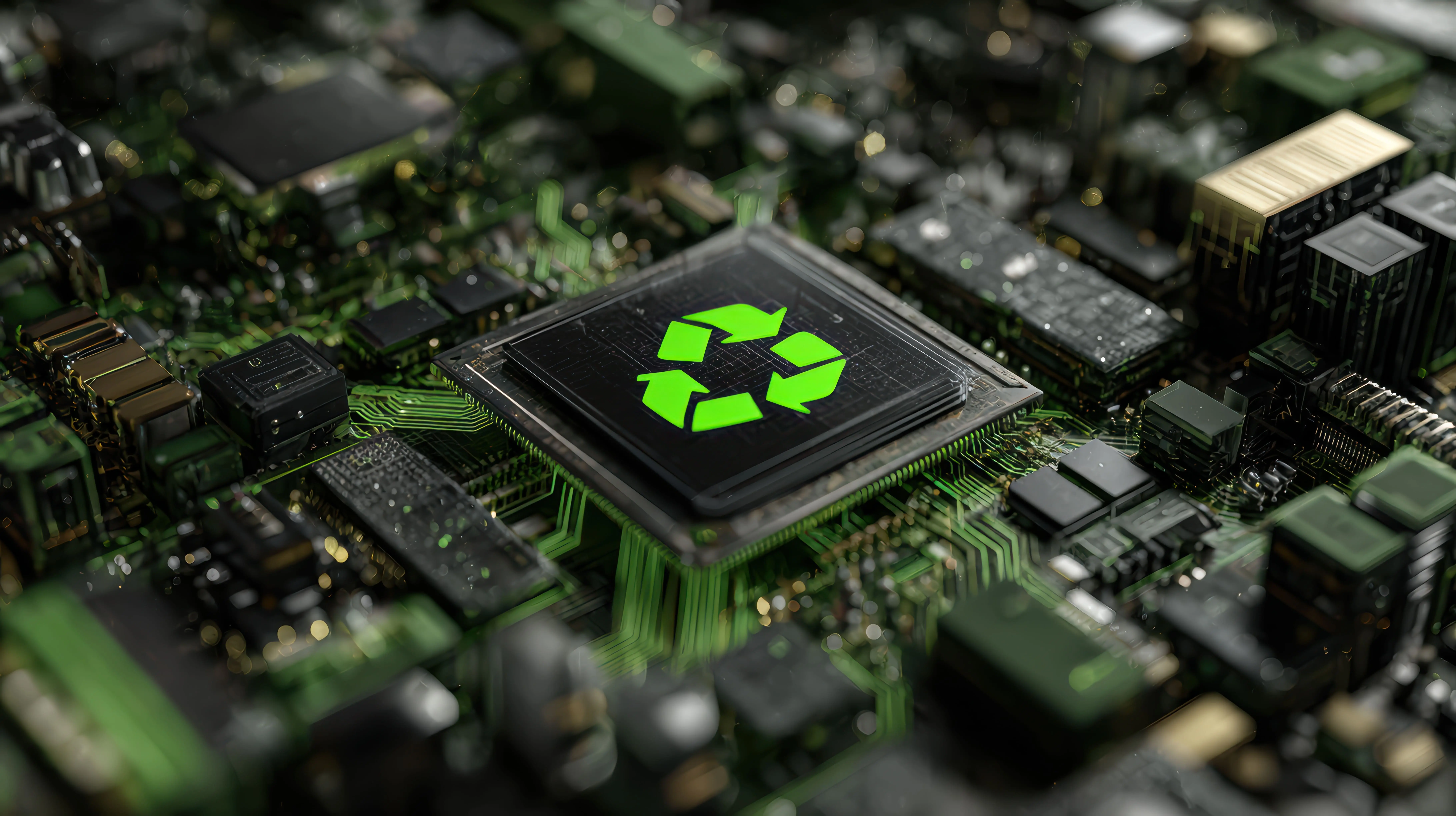The conversation around artificial intelligence sustainability has reached a critical inflection point. We're no longer debating whether AI systems carry an environmental cost, but rather how organisations building these systems can minimise their carbon footprint whilst maintaining the performance businesses require.
At The Virtual Forge, sustainability isn't an afterthought in our AI development process. It's a fundamental consideration that shapes every decision, from selecting cloud infrastructure to managing the lifecycle of physical hardware. What we've learned through hands-on implementation is that building sustainable AI models requires constant vigilance, sophisticated monitoring, and a willingness to make difficult trade-offs.
The Scale of AI's Environmental Challenge
Before explaining our approach, it's worth understanding the magnitude of the challenge. According to the International Energy Agency, data center electricity consumption could more than double between 2024 and 2030, reaching 945 terawatt-hours annually. Research indicates that AI applications could account for 35 to 50 percent of data center power consumption by 2030, a substantial increase from the current 5 to 15 percent.
This growth trajectory creates genuine tension. AI delivers measurable benefits across industries, from healthcare diagnostics to climate modeling. Yet the infrastructure supporting these capabilities carries environmental consequences that cannot be ignored. Major technology companies have already reported significant emissions increases, with some seeing carbon footprints grow by 30 percent or more between 2020 and 2023, largely driven by data center expansion and hardware manufacturing.
The challenge isn't purely about operational energy consumption. Embodied emissions from constructing data centers and manufacturing hardware components can represent one-third to two-thirds of total lifetime emissions. Manufacturing a single high-performance GPU generates approximately 200 kilograms of carbon dioxide, and AI data centers deploy thousands of these processors.

Cloud-First Monitoring: Making Sustainability Measurable
The foundation of our sustainable AI approach centers on comprehensive monitoring of cloud infrastructure. Unlike on-premises deployments where emissions data remains opaque, cloud platforms provide detailed metrics that enable precise carbon accounting.
We rely heavily on the environmental monitoring tools provided by AWS, Microsoft Azure, and Google Cloud Platform. These platforms have developed increasingly sophisticated carbon footprint calculators that track emissions at granular levels, breaking down usage by service, region, and time period.
Google Cloud's Carbon Footprint tool calculates emissions on an hourly basis, matching electricity consumption with the varying mix of energy sources in local grids. This temporal precision allows us to understand not just how much energy our AI workloads consume, but when they consume it and from which sources.
For clients running workloads across multiple cloud providers, we implement Cloud Carbon Footprint, an open-source tool that provides consistent emissions measurement across AWS, Google Cloud, and Azure. This unified approach ensures we're comparing like with like when making infrastructure decisions.
The real power of cloud-based monitoring lies in its actionability. When training a large language model, we can observe emissions in near real-time and adjust accordingly. If a particular region relies heavily on fossil fuel generation during peak hours, we can shift compute-intensive tasks to times when renewable energy dominates the grid mix, or migrate workloads to regions with cleaner energy profiles.
Strategic Hardware Decisions: Beyond Performance Metrics
Whilst cloud monitoring provides visibility into operational emissions, the hardware we specify for on-premises deployments requires a different approach. Physical infrastructure presents both challenges and opportunities for sustainability.
Our hardware procurement process begins with lifecycle assessment. Recent research on AI accelerator lifecycle emissions reveals that manufacturing can contribute approximately half of total lifetime environmental impact. This finding fundamentally changed how we evaluate hardware purchases.
We now consider three primary factors when specifying equipment:
Manufacturing emissions and supply chain transparency.
We prioritise vendors who publish detailed environmental impact data and demonstrate commitment to reducing embodied carbon in their products. This information isn't always readily available, requiring direct engagement with manufacturers.
Energy efficiency during operation.
Newer hardware generations typically offer better performance per watt, but the calculation isn't straightforward. Analysis of Google's Tensor Processing Units shows a threefold improvement in compute carbon intensity from generation four to generation six, demonstrating how hardware evolution can substantially reduce environmental impact.
Geographic sourcing.
Wherever possible, we source hardware from suppliers located near installation sites. This reduces transportation emissions and simplifies logistics. The reality of global supply chains means this isn't always achievable, particularly for specialised AI accelerators with limited manufacturing locations, but it remains a consideration in our procurement decisions.
Physical hardware also requires ongoing operational management that cloud infrastructure handles automatically. We've implemented power management protocols that shut down idle systems overnight and during low-utilisation periods. For clients with batch processing workloads, this can reduce energy consumption by 30 to 40 percent without impacting service delivery.

The Hidden Challenge: On-Premises Hardware Lifecycle
Cloud platforms make sustainability relatively straightforward to monitor and manage. Physical hardware deployed in client facilities presents more complex challenges.
Unlike cloud resources where usage translates directly into measurable emissions through provider tools, on-premises equipment requires manual tracking and measurement. We've developed internal auditing processes specifically for this purpose, cataloging every piece of hardware we deploy, its power consumption characteristics, and its expected operational lifespan.
The most difficult aspect isn't monitoring current equipment but managing end-of-life disposal responsibly. AI hardware components contain rare earth minerals and hazardous materials that create significant electronic waste challenges. We work with certified electronics recyclers who can properly handle GPU decomposition and component recovery, though the infrastructure for AI-specific hardware recycling remains underdeveloped compared to consumer electronics.
Hardware refresh cycles present sustainability dilemmas. Newer equipment operates more efficiently, potentially reducing operational emissions. However, the environmental cost of manufacturing new hardware must be weighed against efficiency gains from replacement. We've adopted a policy of extending hardware lifecycles through targeted upgrades rather than complete system replacements wherever performance requirements allow.
Operational Best Practices That Actually Work
Beyond infrastructure decisions and monitoring tools, sustainable AI development requires operational discipline across the entire model development lifecycle.
Model efficiency comes first. Before considering infrastructure optimisation, we focus on model architecture efficiency. Smaller, well-designed models often achieve comparable performance to larger alternatives whilst consuming a fraction of the computational resources. This isn't always possible when state-of-the-art capabilities are required, but it's our starting point for every project.
Inference optimisation matters more than training. Much attention focuses on the carbon cost of training large models, but research from Google and Meta indicates that inference operations account for 60 to 70 percent of total AI energy consumption, compared to 20 to 40 percent for training. We invest heavily in inference optimisation, using techniques like quantisation and pruning to reduce the computational overhead of deployed models.
Regional selection based on energy mix. Research from Cornell University demonstrates that strategic data center location selection can reduce water consumption by approximately 52 percent and carbon emissions by roughly 73 percent when combined with grid decarbonisation and operational improvements. When deploying cloud workloads, we preferentially select regions with high renewable energy penetration, even when this means slightly higher latency or cost.
Batch processing and temporal shifting. For workloads that don't require real-time processing, we schedule operations during periods of high renewable energy availability. Cloud platforms increasingly support this through carbon-aware scheduling features that automatically shift workloads to minimise emissions.
The Limitations We Face
Transparency requires acknowledging where our approach falls short and where broader industry change is needed.
Current carbon monitoring tools, whilst improving, still have significant gaps. Some major cloud providers continue to omit embodied emissions from their reporting, presenting an incomplete picture of environmental impact. We supplement provider data with third-party estimates, but these remain approximations rather than precise measurements.
The renewable energy credits system used by cloud providers creates accounting complexity. Market-based accounting methods can obscure the actual carbon intensity of electricity used through renewable energy credit purchases that don't match temporal or geographic consumption. We prefer location-based methodologies that reflect the actual grid mix powering our workloads.
For clients requiring cutting-edge AI capabilities, sustainability trade-offs become unavoidable. The most powerful models demand substantial computational resources, and no amount of optimisation eliminates their environmental impact entirely. We're transparent about these trade-offs, helping clients understand when simpler, more sustainable approaches might meet their needs adequately.

What This Means for Your AI Projects
If you're considering AI implementation, sustainability should be part of your evaluation criteria from the outset, not bolted on afterwards.
Start by asking potential partners how they monitor and report environmental impact. Vague commitments to sustainability without specific metrics or methodologies should raise concerns. Look for providers who can show you actual emissions data from previous projects and explain their measurement approach.
Consider the full lifecycle of AI systems, not just operational energy consumption. Organisations must evaluate AI systems at every stage from data selection through model design, training, tuning, and inference to equipment end-of-life. This holistic perspective prevents optimising one area whilst creating problems elsewhere.
Question whether AI is genuinely necessary for your use case. A single generative AI query can consume significantly more energy than a standard search engine query. Sometimes simpler, more sustainable tools deliver adequate results. AI should be deployed intentionally, where its capabilities justify its environmental cost.
Building Sustainable AI Systems That Actually Work
The path toward carbon-neutral AI development isn't straightforward. It requires constant attention, difficult decisions, and acceptance that perfect sustainability remains elusive given current technology constraints.
At The Virtual Forge, we've found that cloud monitoring tools provide the visibility needed to make informed decisions about infrastructure selection and operational practices. We prioritise energy-efficient hardware and extend equipment lifecycles where possible. We optimise model architectures for efficiency and schedule workloads to take advantage of clean energy availability.
These practices don't eliminate AI's environmental impact, but they substantially reduce it. More importantly, they create a framework for continuous improvement as monitoring tools improve, hardware becomes more efficient, and renewable energy penetration increases.
The organisations that will lead in AI aren't those that ignore sustainability concerns or those that refuse to deploy AI due to environmental concerns. They're those that thoughtfully balance capability with responsibility, measuring and minimising their environmental impact whilst delivering genuine value to clients.
If you're developing an AI strategy and want to understand how to implement it sustainably, we're here to help. Our approach combines technical expertise with practical experience in measuring and reducing AI's environmental footprint across diverse deployment scenarios.
Get In Touch
Have a project in mind? No need to be shy, drop us a note and tell us how we can help realise your vision.








.webp)